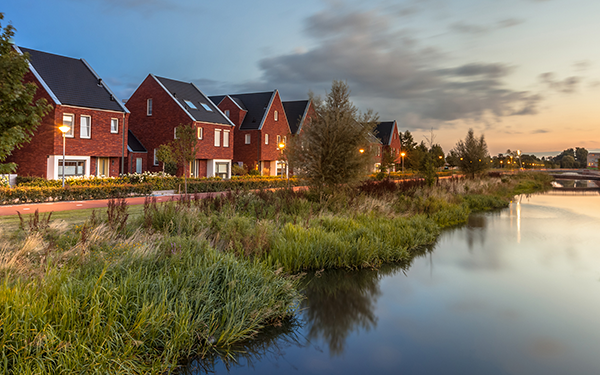A green mortgage gives borrowers preferential terms in the form of lower interest rates, increased loan amounts and many more things.












With climate change constantly in the headlines and the government aiming to make the UK carbon net zero by 2050[1], energy efficiency in the housing sector is coming into sharper focus with ambitious aims for UK new build homes to be highly energy-efficient and zero-carbon ready by 2025[2].
A report from the Intermediary Mortgage Lenders Association (IMLA) has shed light on how the market for green mortgages looks set to gather momentum as we become more eco-aware. Here we look at some of the key findings from IMLA’s research[3] and what it means for the mortgage industry.
What is a Green Mortgage?
Green mortgages are relatively new products, and the market is still in its infancy. In 2017, the Government’s Clean Growth Strategy revealed their blueprint for a low carbon future and introduced the concept of green mortgages in the UK.
A green mortgage gives borrowers preferential terms in the form of lower interest rates, increased loan amounts, or cash incentives, if they can demonstrate the property they are borrowing on meets certain environmental standards, whether that is for a new build or energy efficient renovations to an existing property.
There are benefits for both parties in a green mortgage[4].
For lenders, a borrower with a green mortgage is in a better financial position to pay back the loan as a green building costs less to run.
For the borrower, their energy-efficient property has an increased value over a similar property that does not meet the desired levels of energy efficiency and there are often rewards within the green mortgage itself.
Gathering momentum and breaking down barriers
As with any change, there are challenges for green mortgages. Firstly, UK lender affordability calculations generally do not take energy performance into account, making it difficult to record. However, in 2020, Monmouthshire Building Society became the first UK lender to recognise energy ratings as part of their affordability[5], perhaps encouraging more lenders to follow .
Next, there is a misconception amongst the end-users in the market that green mortgages are more expensive with 33% of consumers in IMLA’s research expecting that to be the case. However, this is not the case with 72% of lenders having launched green products that cost the same as conventional products or less. Interestingly, 20% of consumers indicated that they would be willing to pay an extra £100 a month for a green mortgage if it would lower their carbon footprint, with other drivers for them taking such a product being:
- Saving money on energy bills
- Helping to save the environment
- Making the property more desirable by improving energy efficiency
- Access to better mortgage rates
Additionally, there is a lack of promotion and awareness of green mortgages with IMLA’s research showing that 43% of consumers had never heard of a green mortgage naturally resulting in low demand for the products.
Barclays were the first big lender to launch green mortgage products back in 2018, although Ecology Building Society were the pioneers of such a product as far back as[6]. Barclays were soon followed by lenders such as Nationwide, Saffron Building Society, and Kensington with others indicating an intention to launch green products to market in the[7].
Indeed, specialist lender Foundation Home Loans recently revealed they are launching a ‘Green Reward’ remortgage product as part of its residential range, which will be available to existing homeowners or occupiers who have raised their Energy Performance Certificate (EPC) rating to ‘C’ or above through improvements to their home[8].

Recently, Nationwide Building Society launched a new product called ‘green reward’ which offers £500 cashback to those buying a property with an EPC rating of A, and £250 for properties with an EPC rating of B, to encourage more people to buy more energy-efficient homes. This is in conjunction with their lowest ever advance rate of 0.75% for sustainable home improvements which includes energy-efficient home improvements such as loft, floor, and cavity wall insulation; triple glazing windows; air source heat pumps; and electric car charging stations for which homeowners could borrow between £5,000 and £25,000[9].
IMLA’s report reflects the optimism of the green mortgage market with 58% of intermediaries and 74% of lenders expecting to see demand grow over the next few years.
The hurdles to green mortgages are not insurmountable, and in fact, mostly lie within a lack of understanding of the products, which can be remedied. For example, the government’s Green Finance Strategy put forward a £5m fund to help the financial sector develop green home finance products which triggered the launch of several green mortgage products, helping to raise awareness amongst consumers.
As for future growth, IMLA’s research showed that 74% of lenders believe financial incentives from the government will help to push the market forward. Last year, the government announced a £2bn Green Homes Grant package to help homeowners make energy efficient upgrades to their properties, of which the IMLA report says there are 29 million in the UK.
The lenders’ view
Lenders appear to be dealing with green mortgage in differing ways with many keen to support the market, some offering lower interest rates and some cash incentives. Kensington for instance is rewarding customers with £1,000 cash back incentives on energy efficient or green renovations to existing , whether for buying an older home or simple remortgaging[10].
Furthermore, the mortgage industry is being driven towards green adoption by companies like fund managers BlackRock who have an interest in the UK mortgage market and are responsible for investing trillions into companies that are working towards sustainable practices[11]. Last January, BlackRock wrote to their clients outlining their belief that sustainability risk, and climate risk in particular, mean investment risk and as such sustainability is a key component of the way the way the engage with[12].
Ready for lift off?
Fast forward to 2022 and the Green Finance Institute think this year could be the launch pad for the green mortgage market with products coming to market at an ever-increasing rate. They point out that with £250 billion needing to be invested in UK home upgrades by 2050, the potential capital flow makes this market very appealing[13].
You can find the Green Finance Institute’s handy list of current UK Green Mortgage Products here.
Supporting green mortgages with technology
The green mortgage market needs a brighter light shining upon it and whilst financial incentives from the government are a welcome addition, technology can also play its part too. IMLA‘s report states that 14% of advisers have customers who have enquired about or taken out a green mortgage. Whilst that figure is low, given the information, it is likely to grow. So, advisers should ask themselves if their sourcing software can help to make finding these products simpler?
MortgageBrain sourcing products make it quicker and easier to cut through the noise with advanced filtering that helps find that niche product your client is looking for. Are green mortgages an untapped business opportunity for you?
To find out more about MortgageBrain products and how you can take advantage of a quickly developing market email: [email protected].
References
- [1] https://www.gov.uk/government/news/uk-becomes-first-major-economy-to-pass
- [2] https://www.energylivenews.com/2021/01/20/all-new-build-homes-in-the-uk-to-be-zero-carbon
- [3] http://www.imla.org.uk/resources/publications/imla-green-mortgages.pdf
- [4] https://www.worldgbc.org/news-media/what-are-green-mortgages
- [5] https://www.financialreporter.co.uk/mortgages/new-green-mortgages-to-consider-energy-efficiency
- [6] https://www.whatmortgage.co.uk/news/saffron-joins-lenders-offering-green-mortgages/
- [7] http://www.imla.org.uk/resources/publications/imla-green-mortgages.pdf
- [8] https://www.moneyage.co.uk/foundation-home-loans-launches-green-reward-remortgage.php
- [9] https://www.thisismoney.co.uk/money/mortgageshome/article-9515635/Green-mortgages-Nationwide
- [10] https://www.financialreporter.co.uk/mortgages/kensington-launches-energy-efficiency-reward
- [11] https://www.ft.com/content/57db9dc2-3690-11ea-a6d3-9a26f8c3cba4
- [12] https://www.blackrock.com/corporate/investor-relations/blackrock-client-letter
- [13] https://www.greenfinanceinstitute.co.uk/programmes/ceeb/green-mortgages/




